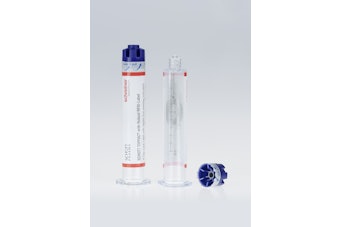What are the primary benefits RFID can deliver for pharmaceutical packagers?
Last year in pharmaceuticals there was more than $2 billion in returns, including overstock product, and 1,300 product recalls initiated either by the FDA or by companies themselves. RFID could dramatically cut down the volume of returns, overstock, and mass recalls. For instance, if one bottle of a particular drug was found to be a counterfeit—say a thief cut out the bottom of the bottle, stole the real product, and replaced it with aspirin to send through the supply chain—if the FDA found that one bottle, often times the entire batch would need to be recalled. RFID would allow the chain of custody of that bottle to be tracked to find who touched it, and also other bottles to be identified from that batch and verified for validity. Right now, companies are taking their own measures to combat counterfeiting, such as using holograms, bar codes, serial numbers, and so on, but those anti-counterfeiting techniques don't empower the FDA when trying to track that package. Nirvana for an FDA Office of Criminal Investigation (OCI) agent would be scanning an RFID tag and seeing where that package has gone throughout its distribution cycle.
What are the primary benefits RFID can deliver for medical device packagers?
A big benefit from a packaging perspective is to create RFID-enabled medical device packaging. Most medical device makers have a significant issue with lost inventory, since much of what they provide hospitals is consigned inventory, meaning they only pay for it when they use it. Since the hospitals don't own it, they don't inventory it particularly well, so there tends to be very little accountability. One of the device manufacturers found more than $100,000 worth of heart catheters in a former hospital president's credenza after he retired. He was in the habit of showing them to doctors and associates, and they never made it back to the inventory room. With RFID, a company would know when it left and who took them. It is also applicable in an operating room to make sure doctors have the right components (replacement parts) for their operations.
How do healthcare firms compare to food and beverage companies when it comes to the use of RFID in the packaging process?
From an adoption standpoint, the pharma and healthcare companies are behind the curve. From a technology standpoint, they're ahead of the curve. In the healthcare industry, there are a smaller number of companies adopting RFID, but those that are implementing RFID are more aggressive. Specifically, food and beverage companies implement RFID primarily at the case and pallet level, while in healthcare, be it nutraceutical, pharmaceutical, or medical, they're using it on the item level. Healthcare firms see a substantially higher return on investment from item-level tagging. Why? Because one bottle of a cancer-fighting medicine may have a value of $1,000, so a 30-cent tag is more justifiable than it is on a $1 bottle of shampoo that might have a 10-cent profit margin.
Describe the "four-phase program" your company employs to develop RFID networks for companies.
We work with pharma firms to create an end-to-end RFID network via a four-part process. First is a planning phase in which we plan a course of action. Next is a physics phase in which we learn the environment of the facility and the RF signature of the items being tagged. In the pilot phase, we create a bill of materials and network architecture. Then we set up and test a system to bring it up to a commercial or production phase. The key to RFID is not, as many software vendors may have you believe, the middleware, nor is it the back-end system integration. First and foremost, the infrastructure is the key. If you don't get 100-percent accurate reads from your infrastructure, the best middleware and the tightest integration are worthless. Using the four-phase process allows you to get the infrastructure right before choosing the most appropriate middleware and integration strategy.
Patrick J. Sweeney II is president and CEO of Odin Technologies, an RFID infrastructure deployment and physics company. Recognized as an industry visionary, he is also the author of the book RFID for Dummies and is involved in standards bodies such as EPCglobal, AIM Global, and CompTIA. In this question-and-answer article, Sweeney addresses the benefits of RFID in healthcare packaging applications.
Last year in pharmaceuticals there was more than $2 billion in returns, including overstock product, and 1,300 product recalls initiated either by the FDA or by companies themselves. RFID could dramatically cut down the volume of returns, overstock, and mass recalls. For instance, if one bottle of a particular drug was found to be a counterfeit—say a thief cut out the bottom of the bottle, stole the real product, and replaced it with aspirin to send through the supply chain—if the FDA found that one bottle, often times the entire batch would need to be recalled. RFID would allow the chain of custody of that bottle to be tracked to find who touched it, and also other bottles to be identified from that batch and verified for validity. Right now, companies are taking their own measures to combat counterfeiting, such as using holograms, bar codes, serial numbers, and so on, but those anti-counterfeiting techniques don't empower the FDA when trying to track that package. Nirvana for an FDA Office of Criminal Investigation (OCI) agent would be scanning an RFID tag and seeing where that package has gone throughout its distribution cycle.
What are the primary benefits RFID can deliver for medical device packagers?
A big benefit from a packaging perspective is to create RFID-enabled medical device packaging. Most medical device makers have a significant issue with lost inventory, since much of what they provide hospitals is consigned inventory, meaning they only pay for it when they use it. Since the hospitals don't own it, they don't inventory it particularly well, so there tends to be very little accountability. One of the device manufacturers found more than $100,000 worth of heart catheters in a former hospital president's credenza after he retired. He was in the habit of showing them to doctors and associates, and they never made it back to the inventory room. With RFID, a company would know when it left and who took them. It is also applicable in an operating room to make sure doctors have the right components (replacement parts) for their operations.
How do healthcare firms compare to food and beverage companies when it comes to the use of RFID in the packaging process?
From an adoption standpoint, the pharma and healthcare companies are behind the curve. From a technology standpoint, they're ahead of the curve. In the healthcare industry, there are a smaller number of companies adopting RFID, but those that are implementing RFID are more aggressive. Specifically, food and beverage companies implement RFID primarily at the case and pallet level, while in healthcare, be it nutraceutical, pharmaceutical, or medical, they're using it on the item level. Healthcare firms see a substantially higher return on investment from item-level tagging. Why? Because one bottle of a cancer-fighting medicine may have a value of $1,000, so a 30-cent tag is more justifiable than it is on a $1 bottle of shampoo that might have a 10-cent profit margin.
Describe the "four-phase program" your company employs to develop RFID networks for companies.
We work with pharma firms to create an end-to-end RFID network via a four-part process. First is a planning phase in which we plan a course of action. Next is a physics phase in which we learn the environment of the facility and the RF signature of the items being tagged. In the pilot phase, we create a bill of materials and network architecture. Then we set up and test a system to bring it up to a commercial or production phase. The key to RFID is not, as many software vendors may have you believe, the middleware, nor is it the back-end system integration. First and foremost, the infrastructure is the key. If you don't get 100-percent accurate reads from your infrastructure, the best middleware and the tightest integration are worthless. Using the four-phase process allows you to get the infrastructure right before choosing the most appropriate middleware and integration strategy.
Patrick J. Sweeney II is president and CEO of Odin Technologies, an RFID infrastructure deployment and physics company. Recognized as an industry visionary, he is also the author of the book RFID for Dummies and is involved in standards bodies such as EPCglobal, AIM Global, and CompTIA. In this question-and-answer article, Sweeney addresses the benefits of RFID in healthcare packaging applications.


















